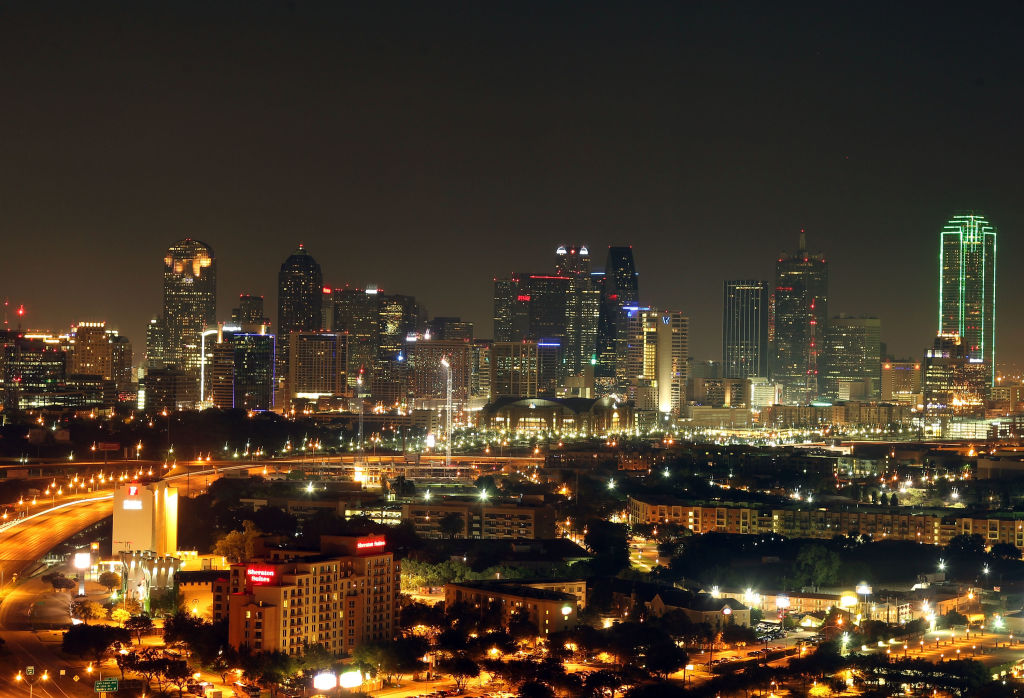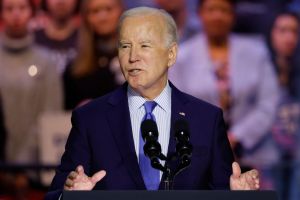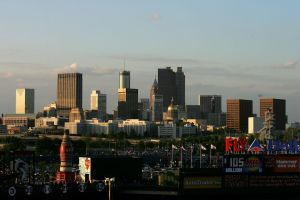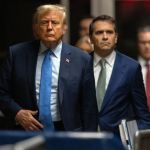“He’s smoking meth,” I heard on the police radio. Lieutenant Jordan Colunga promised to take me to the action, but maintained his leisurely pace. He chuckled as the undercover officers dictated their observations from a gas station. The pipe fiend, having wisely decided he had had his fill, unwisely began wandering the pumps to sell his surplus to passersby. Undercover cops don’t blow their cover for spontaneous drug dealers, so the observers passed along the information to a nearby squad car. The suspect was back in his vehicle by the time the beat cops arrived on scene. “He’s getting out of the car, he’s getting out of the car,” an officer said apprehensively on the radio before yelling, “He’s reaching, he’s reaching!” The laughter stopped. Colunga hit the gas.
We reached the gas station in seconds. The silence on the radio reflected a routine arrest, rather than a gunfight. Now, with the suspect in cuffs in the back of the patrol car, officers teased one another about who could do the most pull-ups. It was noon on a Tuesday in northeast Dallas and I was riding with one of the city’s police units aimed at countering organized and violent crime. “You’re not going to miss [action] very often because crime is so rampant here,” Colunga told me of his team’s aggressive approach to the neighborhoods they work.
Homicides spiked in Dallas each year from 2017 to 2020, peaking amid pandemic lawlessness and public campaigns calling for defunding police forces. The crime surge became the dominant narrative in every major city in the country in 2021, particularly there, because America’s ninth-largest city somehow decreased every violent crime statistic as everyone else seemed to surrender to rampant gunpoint carjackings, shootings, assaults. In 2022, as panicked residents in similar locales recalled lax prosecutors and grim-faced mayors reconsidered their BLM solidarity, Dallas saw violent crime plunge even further. This sudden success was no coincidence.
While other cities defunded departments and told prosecutors not to prosecute, the Dallas Police Department started allocating even more resources to high-crime areas. The strategy, known as “hotspot policing,” was drafted by criminologists, enacted by a new chief, backed by the city’s unapologetically pro-police mayor. Violence has fallen. So have arrests.
Mayor Eric Johnson assumed office in 2019 promising reform. The adoption of hotspot policing had begun to fulfill that promise, but in the wake of the 2020 George Floyd riots, the political grid shifted. Johnson maintained his commitment to public safety in the face of pressure from local and national Democrats — most big city politicians overlook constructive policing reform, he says, because they prioritize politics over a healthy relationship with their police departments.
“It’s more important for them to be good Democrats than good mayors,” Johnson told The Spectator. “They want to be invited to the White House. They want to be on the team. They behave accordingly.” In 2023, the lifelong Democrat became a Republican.
The Dallas Police Department launched a variety of initiatives under the hotspot plan, but the thesis was simple: it would identify areas plagued with violent crime and repeat offenders, then target them until the streets were safe. Research showed that nearly 10 percent of violent street crime was occurring in roughly 0.05 percent of the city. Police then calculated 50 patrol grids of hotspot crime, 330 feet square, where they’d focus their resources. The map shifts every ninety days based on trends in crime data — the grid follows the criminals the way ornithologists follow geese.
Lieutenant Colunga’s investigative team is at the forefront of putting the policy to work. His crew is a hefty collection of covert officers, undercover informants and a sworn federal agent, all of whom focus on gathering intelligence to bust gangs who rule impoverished neighborhoods. Their macho nonchalance is not surprising in a police department. What distinguishes Colunga and his squad is a patience rivaling any birdwatcher’s.
We sat outside a dope house in a large apartment complex. Three young males, likely underage, stood outside, using hand signals to direct operations. A man holding a Gucci bag entered and then quickly left the apartment complex. Gucci man had recently become a suspect as he went in and out of the complex, and in and out again. Our covert car followed him to a nearby gas station where police saw that the registration on his Mercedes-Benz had expired. The flashy suspect, however, was apparently watching his tail; he tore out of the gas station and through a nearby intersection as the light turned yellow, leaving us behind.
A number of large American police departments responded to the crime waves of the Seventies and Eighties with overwhelming displays of force. The “broken windows” theory, which holds that the enforcement of petty crime laws tends to deter other criminal acts before they happen, required high numbers of enforcers. Departments stepped up patrols and arrests of all kinds. Dallas’s hotspot approach, by contrast, requires a more selective approach to action.
“There’s less non-intel driven stops,” Colunga said. “We didn’t just pull over a bunch of random people today. What we used to do in policing is, you just put a bunch of squad cars there and pull over everything that moves — any violation, anything. With this, we know the area, and we have officers building intel. We know they’re doing illegal stuff. It’s getting better results.”
Dallas police leadership often emphasizes that their approach is not about arresting their way out of crime. Dallas adopted hot-spot policing in earnest in the spring of 2021. In its first full year of deployment, arrests fell 10 percent; violent crime decreased by 6 percent even as it surged in most other major cities. The results in high crime areas were even more promising. By the summer of 2022, the city’s most dangerous neighborhood experienced its first decrease in violence in a generation. Its infamous housing complex, Volara Apartments, was off the hotspot list by 2023. Perhaps more interesting is the spillover effect — or lack thereof. While hotspots experienced the steepest drops in crime, the surrounding vicinity, rather than absorbing criminality, saw their crime rates fall as well.
Johnson says those observing his police department’s success at crime reduction should not confuse their approach with controversial stop-and-frisk policies popularized in New York City. “We’ve done it without increasing the number of arrests, which is pretty extraordinary because that’s the standard knock on the approach we’ve taken here,” Johnson told The Spectator. “Hotspot policing looks at the data where the crime is actually occurring and disproportionately uses resources there. [It focuses] on apprehending known violent offenders that have outstanding warrants and legitimate cause for being arrested.”
This attention to repeat offenders and investigative work led to an increase in executing outstanding warrants under the violent crime plan. Colunga says a typical operation for his team involves identifying junkie hangouts, finding probable cause for traffic stops of observed buyers, using confidential informants to buy the drugs at the scene and then obtaining a warrant to bust the drug den. He says residents in crime-ridden areas welcome this approach. “They applaud us as we execute our warrants — they’re sick of the crime,” he told The Spectator. “There’s more support in the apartments and poorer areas than in nicer neighborhoods where they just see us as guys who hand out tickets.”
Colunga’s team has worked to get warrants at the many large apartment complexes in Dallas housing organized criminal activity. While overall violent crime dipped in 2023, the city saw a slight uptick in homicides concentrated around the drug-dealing areas. The department has committed even more resources to address them: Lonzo Anderson, the executive assistant chief over patrol and administrative operations, says police meet weekly with the management of the complexes to discuss ways to curb the violence and drug trafficking. “We talk about what can we do from a criminal standpoint to counter the behavior but then also work with management from a crime prevention standpoint on things they can be working on,” Anderson said.
Surveillance and enforcement are only two prongs in the hotspot strategy. The department also places an equal focus on rehabilitation. When police identify repeat violent offenders, they require them to attend educational meetings as a condition of probation or parole. The criminals hear talks from business leaders, victims of violent crime and former gang members. “They have self-inserted themselves into this situation based on their criminal history. And so we have to treat them. We want them to take advantage of these opportunities,” says Lieutenant Matthew Allie of the violent crime planning unit.
Community leaders have hosted three of these quarterly meetings since the program was launched last year. They resulted in roughly sixty criminals enrolling in the South Dallas Employment Project — a nonprofit that connects them with a selection of nearly 200 community partners who provide services such as jobs, housing, education and transportation. Wes Jurey, a managing partner of the project, says early results showed zero repeated crimes from participants, observing that the program has boosted employment and decreased incarceration rates in poverty-stricken communities. “If we’re really going to get to the heart of the project, it can’t just be about getting some people employed,” Jurey told The Spectator. “It has to be more broadly about beginning to change South Dallas from an area of poverty and dismal demographics to an area of some growth and prosperity.”
Dallas police leadership emphasize that “broken windows” theory informs core aspects of the approach even if they depart strategically from the more famous policing doctrine. “A lot of violent crime is the crime of opportunity,” Major Jason Scoggins, who presides over the violent crime planning unit, said. “When you look at ways to decrease violent crime, essentially you want to make it harder for the opportunity to present itself. So if you have an apartment complex where half the lights are out, then half that [complex] is opportunistic to commit crime. If you make it 100 percent lighting, you possibly eliminated a lot of violent crime that could have potentially taken place.” The department hasn’t just stepped up resources for increased patrol presence, it’s also tending to vacant lots.
Johnson emphasizes that the progress in his city has been worked toward for a long time, and many battles remain against leaders still skeptical of the increased funding needed to counter a police staffing shortage. He first decided to side with police against members of the city council, and later allied with Republicans in the larger fight for tough-on-crime policies. “I made the choice quickly: I’ll be a Democrat in bad standing and be a good mayor,” he said. “And then I made the second choice of, why do I have to be a Democrat in bad standing when I can be a Republican in good standing?”
His decision to switch parties was three years in the making. In 2020, Johnson refused to back cuts to police funds, which led to organized protests at his home. “The protesters showed up at my house every day for weeks in the middle of the night with bullhorns, yelling my name, trying to scare my kids, trying to get me to cut the police budget by 60 percent,” Johnson said. “That put me over the top and made me realize this is the new Democratic Party. It has zero appreciation for public safety and what it takes to keep people safe.”
Then-Dallas police chief Reneé Hall resigned in September 2020 after she faced criticism for her department’s use of force to counter riots after the death of George Floyd in May. Weeks later, the city council passed a budget that cut police funds for overtime and hiring. Still, the mayor never budged on his pro-police stance. Crime continued to spike, and the defunding movement soon fizzled. Eddie Garcia began his duties as Dallas police chief in February 2021 and implemented the violent crime plan three months later. The 2021 implementation may prove historic not just in Dallas, but in the field of law enforcement.
“This is the best relationship I’ve ever seen between city hall, city council, the mayor and the police department,” said Major Scoggins, who has been with the department nearly a quarter century. “Before the crime plan, you did police work the way you knew how but now with the crime plan, there’s a direction. It’s data-driven, you go where the data is. It all plays a part together. You know you have a plan. You know you have a direction. You know you have the support. These guys are doing their job and they’re doing it well.”
Gucci man no doubt breathed a sigh of relief after he dashed through that yellow light. He probably chuckled all the way to the interstate on-ramp — where he found an officer waiting for him, his gun and his Mercedes-full of PCP and crack. The long hours of intelligence work had paid off.
This article was originally published in The Spectator’s April 2024 World edition.


















